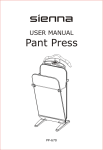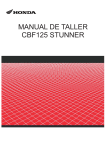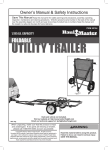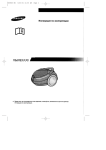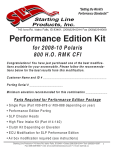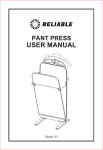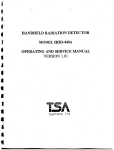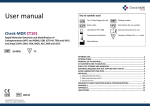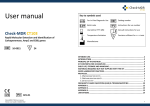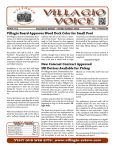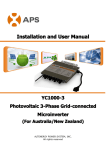Download Honda Rancher 400 service manual 2004-2007
Transcript
8. CYLINDER HEAD/VALVE/CAMSHAFT SYSTEM COMPONENTS .............................. 8-2 VALVE GUIDE REPLACEMENT ............ ...... ·8-12 SERVICE INFORMATION .. ............................ 8-3 VALVE SEAT INSPECTION / REFACING ...... 8-13 TROUBLESHOOTING .................................... 8-5 CAMSHAFT REMOVAL .. · .... · .. · .... · ................ 8-15 CYLINDER COMPRESSiON .......................... · 8-6 CAMSHAFT INSTALLATION ...................... ·8-19 CYLINDER HEAD COVER REMOVALI DiSASSEMBLy .............................................. 8-6 CYLINDER HEAD ASSEMBLY ............ ·........ 8-21 CYLINDER HEAD INSTALLATION .............. ·8-22 CYLINDER HEAD REMOVAL ........................ 8-8 CYLINDER HEAD DiSASSEMBLy ...... ·.......... 8-9 CYLINDER HEAD COVER ASSEMBLYI INSTALLATION ............................................ ·8-24 8-1 CYLINDER HEADIVALVE/CAMSHAFT SYSTEM COMPONENTS , 40 tbf.ft) 54 N'm (5.5 fj 32 N-m (3.3 kgf·m . 24 Ibf·ft ) 12 N·m (1.2 kgf·m . 9Ibf.ft) ( 8-2 J . CYLINDER HEADIV ALVEI CAMSHAFT SERVICE INFORMATION GENERAL • This section covers service of the rocker arms, cylinder head, valves and camshaft. These services can be done with the engine installed in the frame. • When disassembling, mark and store the disassembled parts to ensure that they are reinstalled in their originalloca- lions. • Clean all disassembled parts with cleaning solvent and dry them by blowing them off with compressed air before inspection. • Rocker arm. valve and camshaft lubricating oil is fed through oil passages in the cylinder head and head cover. Clean the oil passages before assembling cylinder head and head cover. • Be careful nOI to damage the mating surfaces when removing the cylinder head cover and cylinder head. SPECIFICATIONS Unit: mm valve guide cam follower " TORQUE VALUES Cylinder head flange cap nut Cam chain tensioner pivot bolt Timing hole cap Exhaust pipe stud bolt Engine hanger bracket bolt (frame side) Engine hanger bracket bolt (engine side) 39 N' m (4.0 kgf.m, 29 Ibf·ft ) 12 N·m (1.2 kgf·m, 9Ibf·ft) 10 N·m (1.0 kgf·m, 7 Ibf·ft) See page 1- 15 54 N'm (5.5 kgf·m , 40 Ibf·ft ) Apply oil to the threads and seating surface Apply a locking agent to the threads 32 N·m (3.3 kgf·m , 24 Ibf·ft ) 8-3 CYLINDER HEADIVALVE/CAMSHAFT TOOLS Compression gauge attacnment 07510-MB00101 Valve spring compressor Valve guide remover, 5.5 mm 07757-0010000 07742-0010100 or equivalent commercially available in U.S.A. Valve guide reamer, 5.510 mm Cutter holder, 5.5 mm 07984-2000001 07781·0010101 Flat cutter, 35 mm (IN 32") 07780-0012300 or 07984-200000D (U.S.A. only) or equivalent commercially available in U.S.A . or equivalent commercially 8vailable in U.S.A . Flat cutter, 30 mm (EX 32'" 07780-0012200 Seat cutter, 35 mm (IN 45") 07780-0010400 Seat cutter, 29 mm (EX 45") or equivalent commercially available in U.S.A. or equivalent commercially avail- or equivalent commercially available in U.S.A. Interior cutter, 37.5 mm (IN 60°) 07780-0014100 Interior cutter, 30 mm (EX 60°) 07780-0014000 or equivalent commerciallv available in U.S.A. or equivalent commercially available in U.S.A. 8-4 able in U.S.A. 07780-0010300 CYLINDER HEADIVALVEI CAMSHAFT TROUBLESHOOTING • Engine top-end problems usually affect engine performance. These can be diagnosed by a compression test, or by tracing top-end noise with a sounding rod or stethoscope. ,. If the performance is poor at low speeds, check for a white smoke in the crankcase breather hose. If the hose is smoky, check for seized piston ring (page 9-2). Compression too low, hard starting or poor performance at low speed • Valves: - Incorrect valve adjustment - Burned or bent valve - Incorrect valve timing - Broken valve spring - Uneven valve seating - Valve stuck open • Cylinder head: - Leaking or damaged cylinder head gasket - Loose spark plug - Warped or cracked cylinder head • Cylinderfpiston problem (page 9-3) Compression too high. overheating or knocking • Excessive carbon build-up on piston head or combustion chamber • Worn or damaged decompressor system Excessive smoke • Worn valve stem or valve guide • Damaged stem seal • Cylinder/piston problem (page 9-3) Excessive noise • Incorrect valve clearance • Sticking valve or broken valve spring • Excessively worn valve seat • Worn or damaged camshaft • Worn rocker arm andlor shaft • Worn rocker arm follower or valve stem end • Worn or damaged push rod andlor cam follower • Worn cam chain • Worn or damaged cam chain tensioner • Worn cam sprocket teeth • Cylinder/piston problem (page 9-3) Rough idle • low cylinder compression 8-5 CYLINDER HEADIVALVE/CAMSHAFT CYLINDER COMPRESSION Warm up the engine to normal operating temperature. COMPRESSION GAUGE Stop the engine, disconnect the spark plug cap and remove the spark plug (page 4-8). Install the compression gauge into the spark plug hole. TOOL: Compression gauge attachment 07510·MB00101 or equivalent commercially available in U.S.A . Shift the transmission in neutral. Open the throttle all the way and crank the engine with the starter motor until the gauge reading stops rising. The maximum reading is usually reached within 4 - 7 seconds. COMPRESSION PRESSURE: 736 kPa (7.5 kgf/cm 2. 107 psi) at 450 rpm Check thai there is no leakage at the gauge connection. low compression can be caused by: - blown cylinder head gasket improper valve adjustment valve leakage worn piston ring or cylinder High compression can be caused by: - carbon deposits in combustion chamber or on piston head CYLINDER HEAD COVER REMOVAl! DISASSEMBLY REMOVAL Remove the fuel tank and heat guard plate (page 625). Remove the timing hole cap. 8-6 r:[!i~'G HOLE CAP CYLINDER HEADIVALVE/CAMSHAFT Turn the crankshaft with the recoil starter and align the "T" mark on the flywheel with the index mark on the rear crankcase cover. INDEX MARK "T" MARK Remove the bolts and cylinder head cover. Remove the dowel pins and gasket. DISASSEMBLY Remove the rocker arm shaft retaining bolts. Push the rocker arm shah with the small screwdriver through the bolt hole until the O-ring on the shaft is removed out of the head cover. BOLTS 8-7 CYLINDER HEADIVALVEI CAMSHAFT Remove the rocker arm shafts, lock washers and rocker arms. INSPECTION ROCKER ARM f SHAFT Check the (ocker arms and shafts for wear or damage. If the rocker arm follower is worn or damaged, check the push rod and oi l passages. Measure each rocker arm shaft 0 .0. SERVICE LIMIT: 11 .92 mm (0.469 in) Measure each rocker arm 1.0. SERVICE LIMIT: 12.05 m m (0.474 in) Subtract each rocker arm shaft 0.0. from the corresponding rocker arm 1.0. to obtain the rocker arm- to-shaft clearance. SERV ICE LIMIT: 0.08 mm (0.003 in) CYLINDER HEAD REMOVAL Remove the following: - carburetor (page 6-7) - exhaust pipe (page 3-14) - cylinder head cover (page 8-6) Remove the bolts and carburetor insulator. Remove the upper engine hanger bracket bolts (engine side). Remove the upper engine hanger bracket bolt (frame side), mounting rubbers and the upper engine hanger bracket. 8-8 CYLINDER HEADIVALVEI CAMSHAFT Remo .... e the push rods. PUSH RODS 1 Remove the two cylinder head mounting bolts and sealing washers. Remove the four cylinder head mounting cap nuts and sealing washers. Do not stnke rhe Remove the cylinder head. cylinder head 100 hard and do no! damage the mating surface with a screwdnver Remove the dowel pins and gasket. Remove the orifice dowel and O-rings. CYLINDER HEAD DISASSEMBLY To prevent loss of Remove the valve spring coners using the valve tension, do nor spring compressor. compress the valve spnngs more than necessary TOOL: Vallie spring compressor 07757-0010000 8-9 • CYLINDER HEADIVALVE/CAMSHAFT Mark all the pares Rem ove the following: so they can be placed back In their onglflallocarions_ - spring retainer inner and outer valve springs valve stem seal STEM SEAL - spring seat RETAINER SPRING ,i VALVE SPRINGS INSPECTION CYLINDER HEAD Remove the carbon deposits from the combustion , - - - -- - - - - - - - - -- - - - , COMBUSTION CHAMBER damage the gaske t chamber, being careful not to damage the gasket surface. surface. Check the spark plug hole and valve areas for Be careful nor to cracks. o o Check the cylinder head for warpage with a straight edge and feeler gauge. SERVICE LIMIT: 0.10 mm (0.004 in) VALVE SPRING Measure the valve spring free length. SERVICE LIMITS: Inner: 37.04 mm (1 .458 in) Oute r: 41.85 mm (1 .648 in) 8-10 CYLINDER HEADIVALVE/CAMSHAFT VAlVEIVALVE GUIDE Check that the valve moves smoothly in the guide. Check the valve for bending, burning or abnormal wear. Measure each valve stem 0 .0 . and record it. SERVICE LIMITS: IN: 5.45 mm (0.215 in) EX: 5.43 mm (0.214 in) Ream the valve guide to remove any carbon buildup before measuring the guide. Insert the reamer from the combustion chamber side of the cylinder head and always rotate the reamer clockwise. TOOLS: Valve guide reamer, 5.510 mm 07964-2000001 or 07984-2000000 (U.S.A. only) Measure each valve guide I.D. and record it. SERVICE liMIT: 5.53 mm (0.218 in) Subtract each valve stem 0.0. from the corresponding guide I.D. to obtain the stem-Ie-guide clearance. SERVICE LIMITS: IN: 0.12 mm (0.005 in) EX : 0.14 mm (0.006 in) Inspect and reface the valve sears whenever the valve gUides are replaced (page8-13!. If the stem·ta-guide clearance exceeds the service limit, determine if a new guide wit h standard dimensions would bring the clearance w ithin talerance. If so, replace any guides as necessary and ream to fit. If the stem·ta-gu ide clearance exceeds the service limit with a new guide, also replace the vallie. 8-11











